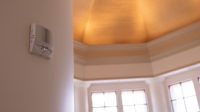One area of life safety protection that is typically slow to change is fire protection. The area is heavily code driven and any change is carefully considered, typically over a period of years, before it is incorporated into fire codes. Nevertheless, technology enhancements are coming to fire protection devices, including sensing and alerting devices. Here we look at several of those enhancements.
Part 1: Sensors
Fire protection sensors include devices such as smoke and carbon monoxide (CO) detectors. Here are some recent trends and advancements.
Making Sensors More Attractive. Although fire codes create a certain level of sameness in fire protection devices, Honeywell uncovered an opportunity to differentiate its offerings through talks with dealers, architects and engineers, notes Samir Jain, global offering leader for the Honeywell Fire unit of Atlanta-based Honeywell Building Technologies.
“Architects, especially, hate smoke detectors,” Jain observes. “They’re thought of as warts on the ceiling.”
In response, he notes, “We’ve spent a lot of time looking at aesthetics.” Honeywell enlisted industrial designers to work on smoke detector housings that would be less obtrusive but still effective, he says.
“The line we launched last year looks more pleasing in color, shape and size” and has been well received by architects, Jain observes.
Products Just Waiting to be Built?
Several of the most recent versions of the NFPA 72 commercial fire code give dealers the option of using IP communications between the customer premises and the central monitoring station via digital cellular or a wireline internet connection. As SDM contributor and NFPA technical committee member Roy Pollack explains, the very latest version of the code, which carries the 2019 designation, takes that a step further and allows the use of IP communications within the customer premises between fire protection devices and the fire control panel using an Ethernet local area network. The 2019 version of the NFPA code refers to this as “Class N” communications and the code describes detailed requirements for Class N equipment.
As Pollack observes, manufacturers have not offered devices designed to use this type of communications because previous versions of the NFPA code didn’t include that option. Conversely, “it wasn’t in the code because nobody was building it,” he explains.
Those responsible for developing the code recognized this and made the decision that “we need to have [Class N communications] in the code to have a starting point to get these things built,” he notes.
Pollack sees some issues that still must be addressed, however. For example, today’s routers, modems and hubs are tested by Underwriters Laboratories (UL) for networking functions and are certified by the FCC for communications, but are not tested as fire system devices.
UL is the entity responsible for testing products to make sure they meet NPFA requirements; but according to Pollack, UL has not yet determined how to test Class N equipment.
Amy Liedman at Potter Electric Signal Company LLC, notes that Potter is working on a Class N fire panel and working with UL on how to test such equipment — and other manufacturers are likely doing the same. Liedman cautions, though, that it could be several years before Class N equipment appears on the market.
Making Sensors More Secure. Life safety manufacturers typically use proprietary protocols for their wireless products, an approach that helps protect devices from hackers. Nevertheless, as concerns about the security of Internet of Things devices increase, some manufacturers are upping their game on device security.
For example, Resideo uses encryption to enhance the security of the two-way wireless technology that underlies the company’s SiX line of devices, including smoke detectors and a recently launched combination smoke/heat and CO detector.
Alice DeBiasio, vice president and general manager of professional security for Austin, Texas-based Resideo, sees encryption as an important talking point for dealers today as they find themselves selling their professionally installed system against do-it-yourself systems.
Technology Advances in CO Detectors. More and more states are adopting requirements for CO detectors, and the latest version of the National Fire Protection Association (NFPA) 72 commercial fire protection code includes CO detector requirements for businesses such as hotels and nursing homes that have sleeping areas. Previously CO detector requirements were in a separate document known as NFPA 720.
As SDM contributor and NFPA technical committee member Roy Pollack explains, those responsible for the codes made the decision to combine the two technologies (smoke and CO) to make requirements easier to read by having them all in one place.
In a similar vein, some manufacturers are combining the two technologies into dual-purpose CO/smoke detectors — an approach that can save on installation time.
Amy Liedman, director of product management for the fire and security division at Potter Electric Signal Company LLC of St. Louis, sees a continued need for single-purpose devices, however. She notes that stand-alone CO detectors are well suited for installations that already have smoke detection but to which the customer wants to add CO detection.
One of the limitations of CO detectors is that they contain chemical elements that degrade over time, requiring the detectors to be replaced after several years. But here, too, manufacturers are making advances. Potter’s CO detector is addressable and is designed to send an email when the sensing element is close to reaching end of life. The device also has an algorithm that can be used for the annual test typically required for installations requiring CO detection, Liedman explains.
Some manufacturers also are improving on the lifespan of CO detectors. As Jain explains, advances on that front have increased the lifespan of Honeywell devices from six to 10 years.
Part 2: Sounding and Alerting Devices
Manufacturers also are making advances in the sounding and alerting devices used in fire protection systems. Here are some of the latest.
IP Paging System Can Support Fire Alerts. Paging systems are getting more sophisticated and can play a key role in fire systems. “A new Viking paging system uses internet protocol (IP) for communications and has the ability to receive multicast audio such as tones or alarm sounds required for evacuation alerts,” says Mike Busby, marketing and sales manager for Viking Electronics Inc., Hudson, Wis. Since the system uses IP for communications, dealers may be able to avoid running new wiring, as would have been required with earlier analog paging systems.
Residential Users See Strong Value in Monitored Fire Systems
Residential users generally are not required to have a central station monitor the smoke detectors in their homes. But recent research from Parks Associates shows that monitored smoke, fire and carbon monoxide detectors have strong appeal in U.S. broadband households. Such devices were the third most appealing of eight potential smart home capabilities in a recent Parks Associates survey, coming in just slightly behind burglar alerts and “smoke, fire or carbon monoxide detectors that send alerts to the end user.”
Wireless Audio/Visual Devices. Designing a wireless audio/video device to meet code requirements traditionally has been a non-starter. Batteries just couldn’t provide enough power to keep lights and sounders working for the amount of time required. But that’s changing.
Jain notes, for example, that Honeywell’s latest A/V devices were developed to use less power. He sees these as a real value proposition because dealers can avoid the labor and wiring required to install traditional wired devices.
Improving Residential Alerts. Commercial fire codes have stringent requirements about alerting devices, with the goal of enabling people to get an alert throughout a building. Those strict requirements don’t exist on the residential side, however, which means that it can be difficult for residents to hear fire alarms throughout the house.
When Resideo developed its SiX two-way wireless system, designers saw a way to help address that issue. The system has a feature the company calls “One-Go-All-Go” that triggers multiple sounding devices throughout the home when smoke is detected.
DeBiasio notes that this could have been a big benefit when an ember from her fireplace set her downstairs couch on fire. She happened to be downstairs at the time, but just as easily might have left the fire to burn out and gone upstairs where she wouldn’t have heard a traditional smoke alert.
Clearly, manufacturers aren’t sitting still when it comes to fire protection equipment, but continue to make advances in sensors, alerting and other devices. (See “Products Just Waiting to Be Built?” on page XX.) The latest version of the NFPA code is expected to pave the way for even more advances.
More Online
For more on this topic visit SDM’s website where you will find the following articles: coverage at these links:
“New Year, New Code”
www.SDMmag.com/new-year-new-code
“Parks Associates Releases New Paper on Fire Prevention Solutions”
www.SDMmag.com/parks-associates-releases-white-paper-on-fire-prevention-solutions
“Thinking Outside the Box About CO & Smoke Detectors”
www.SDMmag.com/thinking-outside-the-box-about-co-smoke-detectors
“NFPA Members Vote Overwhelmingly to Accept Updated Language on Fire Alarm Monitoring”
www.SDMmag.com/nfpa-members-accept-updated-language-on-fire-alarm-monitoring
“State of the Market: Fire Alarms”
www.SDMmag.com/state-of-the-market-fire-alarms-2018






